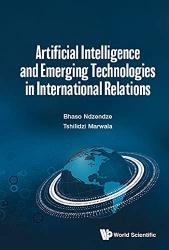 Название: Artificial Intelligence And Emerging Technologies In International Relations
Название: Artificial Intelligence And Emerging Technologies In International RelationsАвтор: Bhaso Ndzendze, Tshilidzi Marwala
Издательство: World Scientific
Год: 2021
Страниц: 190
Язык: английский
Формат: pdf (true), epub
Размер: 10.2 MB
Artificial Intelligence and Emerging Technologies in International Relations explores the geopolitics between technology and international relations. Through a focus on war, trade, investment flows, diplomacy, regional integration and development cooperation, this book takes a holistic perspective to examine the origins of technology, analysing its current manifestations in the contemporary world. The authors present the possible future roles of Artificial Intelligence (AI) and other emerging technologies (including blockchain, 3D printing, 5G connectivity and the Internet of Things) in the context of global arena. This book is essential reading to all who seek to understand the reality of the inequitable distribution of these game-changing technologies that are shaping the world. Research questions as well as some policy options for the developing world are explored and the authors make the case for cooperation by the international community as we enter the fourth industrial revolution (4IR).
The defining technologies of the 4IR that have a productive component and an IR interface are summarized and include Artificial Intelligence, Big Data, 5G, 3D printing (also known as additive manufacturing), new materials (such as graphene), the Internet of Things (IoT), and Blockchain.
Artificial Intelligence, perhaps the defining technology of the 4IR, is not a singular industry or field of study and research. Rather it refers to a variety of algorithm-based machines and processes which can act autonomously, learning as they do so through Machine Learning (ML) and in so doing appear to mimic the cognitive as well as behavioural patterns of human beings. Within AI, there are specialised areas of robotics, Natural Language Processing (NLP) and ML. The last of these three is the leading area of growth, with some 60% of funding in AI being in ML. Briefly, the ML value chain consists of the following steps: (1) Data collection; (2) Data storage; (3) Data preparation; (4) Algorithm training, and (5) Application development. These stages involve (1) obtaining raw data; (2) placing these raw data in data centers; (3) conversion, formatting and labelling of these raw data; (4) configuring an algorithm that can make predictions based on the data; and (5) converting these algorithmic predictions into commercial products and applications such as software with installations in mobile apps, medical diagnostic tools, military equipment, geospatial observation and self-driving automobiles.
At its most basic and general form, AI is a technology that looks at how a human brain functions and designing a computer that is able to perform the same functions. As a result, AI programmers are able to create machines that perform well on tasks that humans are able to do, such as in production, as well as analysis and prediction; the latter two being the most directly relevant and thus the focus of this section. AI machines are intelligent, autonomous and able to adapt and evolve beyond the specifications given by their human designers, especially in the wake of Machine Learning, quantum computing, soft computing and access to Big Data.
Скачать Artificial Intelligence And Emerging Technologies In International Relations